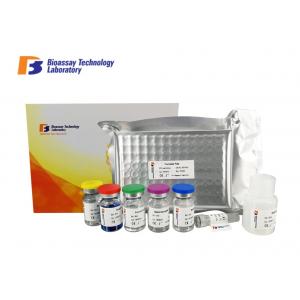Professional Ps Human Elisa Kit Customized Accurate Quantitative Detection
Add to Cart

High Precision and Sensitivity Human PS ELISA Kit 96 Wells 48 Wells Customized
Cat.No E0201Hu
Standard Curve Range: 0.5ng/ml - 200ng/ml
Sensitivity: 0.22ng/ml
*This product is for research use only, not for use in diagnosis procedures. It’s highly recommend to read this instruction entirely before use.
Precision
Intra-Assay Precision (Precision within an assay) Three samples of known concentration were tested on one plate to assess intra-assay precision.
Inter-Assay Precision (Precision between assays) Three samples of known concentration were tested in separate assays to assess inter-assay precision.
CV(%) = SD/mean x 100
Intra-Assay: CV<8%
Inter-Assay: CV<10%
Intended Use
This sandwich kit is for the accurate quantitative detection of human Platelet Selectin (also known as P-S) in serum, plasma, cell culture supernates, cell lysates, tissue homogenates.
Material Required But Not Supplied
- 37°C±0.5°C incubator
- Absorbent paper
- Precision pipettes and disposable pipette tips
- Clean tubes
- Deionized or distilled water
- Microplate reader with 450 ± 10nm wavelength filter
Specimen Collection
Serum Allow serum to clot for 10-20 minutes at room temperature. Centrifuge at 2000-3000 RPM for 20 minutes.
Plasma Collect plasma using EDTA or heparin as an anticoagulant. Centrifuge samples for 15 minutes at 2000-3000 RPM at 2 - 8°C within 30 minutes of collection.
Urine Collect by sterile tube. Centrifuge at 2000-3000 RPM for approximately 20 minutes. When collecting pleuroperitoneal fluid and cerebrospinal fluid, please follow the procedures above-mentioned.
Cell Culture Supernatant Collect by sterile tubes when examining secrete components. Centrifuge at 2000-3000 RPM for approximately 20 minutes. Collect the supernatants carefully. When examining the components within the cell, use PBS (pH 7.2-7.4) to dilute cell suspension to the cell concentration of approximately 1 million/ml. Damage cells through repeated freeze-thaw cycles to let out the inside components. Centrifuge at 2000-3000 RPM for approximately 20 minutes.
Tissue Rinse tissues in PBS (pH 7.4) to remove excess blood thoroughly and weigh before homogenization. Mince tissues and homogenize them in PBS (pH7.4) with a glass homogenizer on ice. Thaw at 2-8°C or freeze at -20°C. Centrifuge at 2000-3000 RPM for approximately 20 minutes.
*Sample can't be diluted with this kit. Owing to the the material we use to prepare the kit, the sample matrix interference may falsely depress the specificity and accuracy of the assay.
Assay Procedure
1. Prepare all reagents, standard solutions and samples as instructed. Bring all reagents to room temperature before use. The assay is performed at room temperature.
2. Determine the number of strips required for the assay. Insert the strips in the frames for use. The unused strips should be stored at 2-8°C.
3. Add 50μl standard to standard well. Note: Don’t add antibody to standard well because the standard solution contains biotinylated antibody.
4. Add 40μl sample to sample wells and then add 10μl anti-P-S antibody to sample wells, then add 50μl streptavidin-HRP to sample wells and standard wells (Not blank control well). Mix well. Cover the plate with a sealer. Incubate 60 minutes at 37°C.
5. Remove the sealer and wash the plate 5 times with wash buffer. Soak wells with at least 0.35 ml wash buffer for 30 seconds to 1 minute for each wash. For automated washing, aspirate all wells and wash 5 times with wash buffer, overfilling wells with wash buffer. Blot the plate onto paper towels or other absorbent material.
6. Add 50μl substrate solution A to each well and then add 50μl substrate solution B to each well. Incubate plate covered with a new sealer for 10 minutes at 37°C in the dark.
7. Add 50μl Stop Solution to each well, the blue color will change into yellow immediately.
8. Determine the optical density (OD value) of each well immediately using a microplate reader set to 450 nm within 10 minuets after adding the stop solution.
Summary
1. Prepare all reagents, samples and standards.
2. Add sample and ELISA reagent into each well. Incubate for 1 hour at 37°C.
3. Wash the plate 5 times.
4. Add substrate solution A and B. Incubate for 10 minutes at 37°C.
5. Add stop solution and color develops.
6. Read the OD value within 10 minutes.
Calculation of Result
Construct a standard curve by plotting the average OD for each standard on the vertical (Y) axis against the concentration on the horizontal (X) axis and draw a best fit curve through the points on the graph. These calculations can be best performed with computer-based curve-fitting software and the best fit line can be determined by regression analysis.
Referances
Takano M., Meneshian A., Sheikh E., Yamakawa Y., Wilkins K.B., Hopkins E.A., Bulkley G.B.
Am. J. Physiol. Heart Circ. Physiol. 283:H2054-61(2002)


